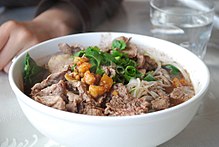This is an old revision of this page, as edited by Chaotic Enby (talk | contribs) at 15:17, 3 January 2025 (not a stub). The present address (URL) is a permanent link to this revision, which may differ significantly from the current revision.
Revision as of 15:17, 3 January 2025 by Chaotic Enby (talk | contribs) (not a stub)(diff) ← Previous revision | Latest revision (diff) | Newer revision → (diff) Thai breakfast dishThis article has multiple issues. Please help improve it or discuss these issues on the talk page. (Learn how and when to remove these messages)
|
 | |
| Course | Breakfast, lunch, and dinner |
|---|---|
| Place of origin | Thailand |
| Region or state | Southeast Asia |
| Associated cuisine | Thai |
| Created by | Thai |
| Main ingredients | Rice noodles, pork, beef, poultry, seafood, broth |
| Food energy (per serving) | 400 kcal (1675 kJ) |
| Similar dishes | Kuyteav, kyay oh, shahe fen, "Hủ tiếu" |
| Kuai tiao | |||||||||||
|---|---|---|---|---|---|---|---|---|---|---|---|
| Chinese name | |||||||||||
| Chinese | 粿條 | ||||||||||
| |||||||||||
| Vietnamese name | |||||||||||
| Vietnamese alphabet | hủ tiếu | ||||||||||
| Thai name | |||||||||||
| Thai | ก๋วยเตี๋ยว | ||||||||||
Kuai Tiao Thai (Thai: ก๋วยเตี๋ยวไทย, RTGS: kuaitiao thai) is a Thai noodle dish eaten in Thailand, Known for its versatility, affordability, and rich flavors.
Origin
The history of Kuai Tiao Thai can be traced back to the influence of Chinese immigrants in Thailand during the Ayutthaya period (1350–1767). Chinese traders brought their culinary traditions, including noodle-making techniques, to the region. Over time, these influences were adapted and integrated with local Thai ingredients and flavors.
Vajiravudh (reigned 1910–1925) is often credited with popularizing Kuai Tiao Thai as a street food. During his reign, the dish became a practical solution to urbanization and the need for quick, affordable meals.
Types of Kuai Tiao in Thailand
- ก๋วยเตี๋ยวเรือ (Kuai Tiao Reua): Known as "boat noodles," this dish originated from vendors who sold noodles from boats along canals. The broth is often made with a combination of pork or beef blood, spices, and dark soy sauce. It’s typically served in small portions to mimic its original preparation on boats.
- ก๋วยเตี๋ยวต้มยำ (Kuai Tiao Tom Yum): This variation incorporates the Thai tom yum flavors of spicy, sour, and tangy. It often includes lime juice, chili flakes, peanuts, and sometimes a touch of sugar.
- ก๋วยเตี๋ยวเย็นตาโฟ (Yong tau foo): Yen Ta Fo has bright pink broth, flavored with fermented bean paste. This dish is often served with fish balls, tofu.
- ก๋วยเตี๋ยวแห้ง (Kuai Tiao Haeng): This dry noodle dish is served without broth. Instead, it’s mixed with seasonings such as soy sauce, garlic oil, and chili, often accompanied by a side of soup.
- ก๋วยเตี๋ยวสุโขทัย (Sukhothai rice noodles): Originating from the Sukhothai province, this dish has a sweet and tangy flavor. It includes thin rice noodles, ground pork, green beans, and peanuts, often garnished with lime and fresh herbs.
- ก๋วยเตี๋ยวลูกชิ้นปลา (Kuai Tiao Look Chin Pla): Fish ball noodles are a lighter option, featuring clear broth and handmade fish balls.
- ก๋วยเตี๋ยวเป็ด (Kuai Tiao Ped): Duck noodle soup features braised duck, spices, and sometimes medicinal herbs.
Key ingredients and noodle varieties
The foundation of Kuai Tiao Thai lies in its noodles, which come in various forms:
- เส้นเล็ก (Sen Lek): Thin rice noodles
- เส้นใหญ่ (Sen Yai): Wide rice noodles
- บะหมี่ (Ba Mee): Egg noodles
- วุ้นเส้น (Woon Sen): Glass noodles made from mung bean starch
Common toppings include sliced meats (pork, chicken, beef, or duck), fish balls, tofu, and vegetables like bean sprouts and morning glory. Broths are often enriched with aromatic herbs, spices, and condiments such as fish sauce, vinegar, and chili flakes, allowing diners to customize their bowls to taste.
References
- John Welford. The Origin of Pasta: The Marco Polo Connection.
- มหาวิทยาลัยสุโขทัยธรรมาธิราช โครงการเลือกสรรหนังสือ. ว่าด้วยที่ค้าขายนอกกรุง. คำให้การขุนหลวงวัดประดู่ทรงธรรม เอกสารจากหอหลวง (หน้า 8).
- สุกัญญา สุจฉายา. อาหารไทยสมัยกรุงศรีอยุธยา. วารสารมนุษยศาสตร์ปีที่ 24 ฉบับที่ 2, กรกฎาคม-ธันวาคม 2560
- ม.ร.ว.คึกฤทธิ์ ปราโมช, 2490. สี่แผ่นดิน
- โรม บุนนาค. รัฐนิยมของจอมพล ป. เมื่อไทยจะเป็นมหาอำนาจ. เรื่องเก่าเล่าปัจจุบัน
- ชาติชาย มุกสง. 2475 กับการปฏิวัติรสชาติอาหาร : จากการกินเพื่ออยู่สู่การกินพื่อชาติและการต่อสู้ทางวัฒนธรรมของรสชาติในสังคมไทยร่วมสมัย. จาก ๑๐๐ ปี ร.ศ.๑๓๐ ถึง ๘๐ ปีประชาธิปไตย
| This article needs additional or more specific categories. Please help out by adding categories to it so that it can be listed with similar articles. (January 2025) |